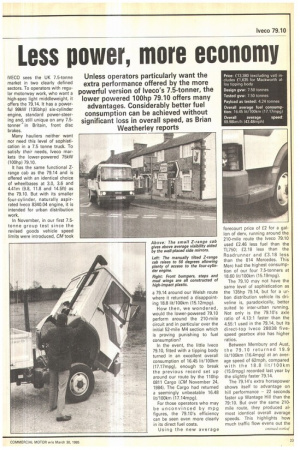Less power, more economy
Page 27

Page 28

If you've noticed an error in this article please click here to report it so we can fix it.
IVECO sees the UK 7.5-tonne market in two clearly defined sectors. To operators with regular motorway work, who want a high-spec light middleweight, it offers the 79.14. It has a powerful 99kW (135bhp) six-cylinder engine, standard power-steering and, still unique on any 7.5 i tonner n Britain, front disc brakes.
Many hauliers neither want nor need this level of sophistication in a 7.5 tonne truck. To satisfy their needs, Iveco markets the lower-powered 75kW (100hp) 79.10.
It has the same functional Zrange cab as the 79.14 and is offered with an identical choice of wheelbases at 3.0, 3.6 and 4.41m (9.8, 11.8 and 14.5ft) as the 79.10. But with its smaller four-cylinder, naturally aspirrated Iveco 8340.04 engine, it is intended for urban distribution work.
In November, in our first 7.5tonne group test since the revised goods vehicle speed limits were introduced, CM took
Left: The manually tilted Z-range cab raises to 50 degrees allowing plenty of access to the four-cylinder engine.
Right: Front bumpers, steps and mud wings are all constructed of high-impact plastic.
a 79.14 around our Welsh route where it returned a disappointing 18.8 lit/100km (15.12mpg).
How then, we wondered, would the lower-powered 79.10 perform around the 210-mile circuit and in particular over the initial 52-mile M4 section which is proving punishing to fuel consumption?
In the event, the little Iveco 79.10, fitted with a tipping body turned in an excellent overall consumption of 16.45 lit/100km (17.17mpg), enough to break the previous record set up around our route by the 110hp 0811 Cargo (CM November 24, 1984). The Cargo had returned a seemingly unbeatable 16.48 lit/100km (17.14mpg).
For those operators who may be unconvinced by mpg figures, the 79.10's efficiency can be seen even more clearly in its direct fuel costs.
Using the new average forecourt price of E2 for a gallon of derv, running around the 210-mile route the Iveco 79.10 used £2.46 less fuel than the TL750; £2.18 less than the Roadrunner and £3.18 less than the 814 Mercedes. This Merc had the highest consumption of our four 7.5-tonners at 18.60 lit/100km (15.19mpg).
The 79.10 may not have the same level of sophistication as the 135hp 79.14, but for a urban distribution vehicle its driveline is, paradoxically, better suited to inter-urban running. Not only is the 79.10's axle ratio of 4.13:1 faster than the 4.55:1 used in the 79.14, but its direct-top Iveco 28038 fivespeed gearbox also has higher ratios.
Between Membury and Aust, the 79.10 returned 19.9 lit/100km (16.4mpg) at an average speed of 62mph, compared with the 18.8 lit/100km (15.0mpg) recorded last year by the slightly faster 79.14.
The 79.14's extra horsepower shows itself to advantage on hill performance 22 seconds faster up Wantage Hill than the 79:10. But over the same 210mile route, they produced almost identical overall average speeds. This highlights how much traffic flow evens out the differences in engine capacity.
Operators should ask themselves whether the extra performance of the 135hp is really worth the losses in fuel economy.
Iveco quotes a maximum geared speed of 61mpg for the 100hp 79.10, although on the M4 the Z-range tipper maintained 65mph easily enough on overrun, even touching 70mph on downhill gradients. At these speeds the four-cylinder engine revving at 2,800rpm proved surprisingly relaxed although at 65mph the interior cab noise level was understandably higher than average at 84 dB(Al. Throughout our test a badly fitting quarterlight also set up a persistent whistle at
Below: 79.10 has dual-circuit hydraulic brakes with the Vane-type exhauster providing vacuum assistance. The more-powerful 135hp 79.14 is equipped with a full air-hydraulic braking system. Above: Instrumentation is limited to tachograph, temperature and fuel gauges, warning lights but no rev counter. The heater controls are badly sited below the centre of the dashboard and are difficult to reach.
speeds above 50mph, The direct-top Ivaco fivespeed box has a well defined shift pattern and seems generally well matched to the fourcylinder engine although there is a slight gap between third and fourth ratios.
Compared with the interior of the Ford Cargo and the recently revised Bedford TL, Iveco's 7.5tonne Z-range cab has a rather spartan look.
Although the 79.10's steering does not have the luxury of power-assistance it proved light and positive, particularly around the twisting B-roads between Marstow and Hereford. Over this section the little Iveco 7.5-tonner also handled excel Despite the move by some manufacturers towards fitting single-leaf springs at 7.5 tonnes, Iveco continues to fit multi-leaf units all round on the 79.10 and 79.14. The result on both vehicles is a firmer than average ride, but one which gives the driver a far greater feeling of control, particularly when cornering.
While there is little to separate the 79.10 and 79.14 externally, a noticeable difference in their braking characteristics soon became evident around our route. On the steep descent down to our lunch stop at Berrow the 79.10's vacuumassisted drum brakes lacked the bite of the 79.14's air-over-hydraulic system with its front disc brakes.
All daily checks can be carried out without having to raise the manually tilted Z-range cab. Access to the engine oil filter and dipstick is via the front liftup panel. The hydraulic clutch reservoir and electrics can be reached from inside the cab.
lveco's 7.5-tonne 79.10 may not have quite the same level of comfort or sophistication as the Mercedes 814 or Leyland's Roadrunner, but there can be no doubting its excellent fuel economy. The Z-range cab provides a practical workplace and the 4.82 tonne body payload allowance is among the most competitive in its class as is its f11,745 chassis price.
























































































































































